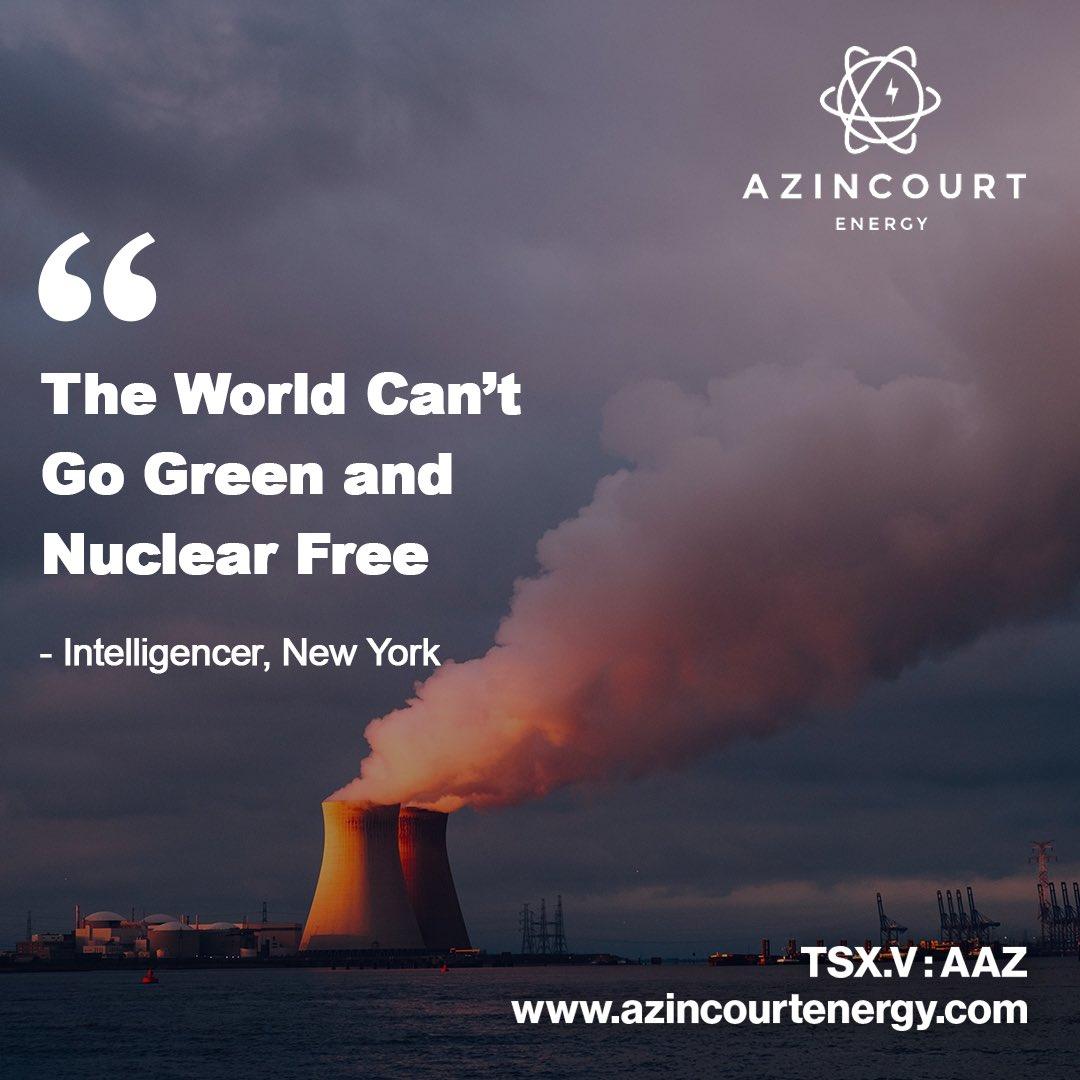The world has learned to stop worrying and love nuclear energy. Or some of the world has, anyway.
The nuclear industry spent the bulk of the past decade in nonliteral meltdown. The Fukushima disaster of 2011 triggered a global backlash against atomic energy. In its wake, Japan suspended nearly its entire nuclear fleet, Germany opted to phase out its nuclear plants, and various other nations either halted, delayed, or canceled planned expansions of nuclear energy.
The industry’s political woes were soon compounded by economic ones. As America’s shale revolution flooded the world with cheap gas and the mass deployment of wind and solar yielded rapid cost reductions in renewables, nuclear energy struggled to compete. To some climate hawks, the long-running, intra-environmentalist debate over whether nuclear was a truly “clean” energy source began to look moot: Who needs the hassle of radioactive waste when building out renewables is faster and cheaper?
But over the past couple of years, nuclear has acquired a new glow. In 2021, Congress invested more than $8 billion in subsidizing existing nuclear plants and bankrolling advanced nuclear demonstration projects, while private investors poured billions more into American nuclear-energy start-ups. Two such firms, TerraPower and X-energy, have plans pending before the U.S. Nuclear Regulatory Commission. If President Joe Biden gets his way, Congress will soon incentivize new nuclear production with a special tax credit. And on that matter, Biden is fairly likely to get his way: Boosting nuclear is one of the few items on the president’s climate agenda that boasts Senator Joe Manchin’s enthusiastic support. Last month, America’s two most universally beloved celebrities, Grimes and Elon Musk, took to social media to advocate for the maintenance of existing nuclear power plants.
Meanwhile, the European Commission recently leaked plans to formally declare nuclear energy a “green” investment. More than a half dozen states from across the region are currently pursuing advanced-nuclear power plants. And China, the world’s biggest carbon emitter, recently unveiled plans to build 150 new nuclear reactors in the next 15 years — more than the rest of the world has built in the past three decades.
On net, these developments are encouraging. Burgeoning support for nuclear energy reflects, in part, a recognition of renewables’ current liabilities and the adverse consequences denuclearization has had on global emissions. At the same time, nuclear power still suffers from deficiencies that limit its utility in the fight against climate change. In deference to these realities, the U.S. should redouble its support for existing nuclear plants and pursue regulatory reforms that facilitate the development and deployment of safe, cost-effective nuclear technologies (should they one day exist) without putting all that many eggs in the nuclear basket.
The primary reason for nuclear’s rebounding support is simple: It’s probably impossible for the world to meet its emissions-reduction targets without a substantial global expansion of atomic energy. The U.N. Intergovernmental Panel on Climate Change has identified four model pathways for avoiding more than 1.5-degree warming. Three of these involve increasing nuclear’s share of primary energy provision by between 150 and 500 percent; none allow for nuclear’s share to decline far from its 2018 level.
When the International Energy Agency tried to map out a path to net-zero global emissions by 2050, it found that hitting that target would likely require doubling worldwide nuclear-power production.
Although more vital at the global level, building new nuclear plants — or failing that, maintaining existing ones — would ease America’s path to decarbonizing its entire economy by mid-century. Princeton University researchers recently modeled a variety of pathways for achieving full decarbonization in the U.S. by 2050 and found that the cheapest pathway, given existing technology, involved tripling nuclear-power generation.
Nuclear’s indispensability is a function of renewables’ persistent liabilities.

Cost reductions in the renewable sector have been truly phenomenal. The past decade witnessed a ninefold reduction in the cost of solar energy, a 40 percent drop in that of wind power, and a 70 percent plunge in utility-scale batteries. Project that breakneck pace of innovation forward and it can seem like nuclear’s obsolescence is nigh.
At present, however, there isn’t any scalable solution to renewables’ intermittency problem, or at least not one that would allow America to live on renewable electricity alone. Standard lithium-ion batteries can store solar and wind energy for hours but not for days or weeks. To avert power failures amid seasonal fluctuations in wind speeds and sunlight, we still need a foundation of “firm” energy on our grids. And among proven technologies, nuclear is the most reliable source of round-the-clock non-carbon power.
Last year’s energy crunch threw a spotlight on this reality. Thanks in part to the global economy’s unexpectedly rapid recovery from the COVID-19 recession, oil and gas prices spiked last year. In Europe, these cost burdens were compounded by unusually slow winds and limited rainfall, which yielded a smaller-than-anticipated supply of renewable power. And yet, throughout the resulting energy crisis, nuclear-power plants provided a constant supply of non-carbon power at a stable price. This demonstration of the energy source’s resilience bolstered nuclear’s advocates on the continent.
Meanwhile, the emissions trajectories of nations that curbed nuclear plants over the past decade illustrated renewables’ present inadequacies. In Germany, energy lost to the phasing out of nuclear was replaced primarily by coal-fired power plants. This not only undermined the nation’s pursuit of carbon neutrality, it also increased the lethality of its energy system. A 2019 paper from the National Bureau of Economic Research estimated that Germany’s nuclear phaseout increased pollution-induced deaths by about 1,100 a year. That finding reflects a reality that nuclear’s champions are wont to emphasize: For all the safety concerns that atomic energy inspires, it is exponentially less damaging to public health than fossil energy. Even if one accepts the highest scientific estimate of the Chernobyl disaster’s death toll, the worst nuclear accident in history still killed a tiny fraction of the number of people that fossil-fuel plants kill annually while working as designed.
Japan’s nuclear phaseout has been similarly ill-fated. The carbon intensity of the nation’s power sector soared following the post-Fukushima closures. And now the Japanese government’s climate advisory group is warning that the country will be incapable of meeting its emissions-reduction targets unless it restarts nearly every nuclear plant it took off-line last decade.
These developments demonstrate the importance of keeping existing nuclear plants online unless or until breakthroughs in renewable-energy storage ensures that lost atomic energy will not be supplanted by carbon sources.
Beyond intermittency, renewables have other liabilities that have bolstered the case for subsidizing advanced-nuclear technologies. One leading drawback of atomic energy is its political unpalatability. And yet, while renewable energy is extremely popular in the abstract, wind and solar have their own political difficulties in practice. Both energy sources are far more land-intensive than nuclear. They will also likely require vast expansions in energy-transmission infrastructure. According to Princeton’s study, achieving net-zero emissions by mid-century through renewables alone would require quintupling electricity transmission so as to move energy generated in far-flung solar and wind farms to population centers.
All this means that building out enough renewable capacity to fully decarbonize the electrical grid will require winning a dizzying number of discrete land-use battles. Which will be profoundly difficult since even environmental groups cannot be trusted to support building out renewables or high-voltage transmission lines in their (figurative) backyards. In just the past few months, three of Maine’s top “green” groups helped block a transmission line that would have brought hydropower from Canada in the name of preserving their state’s “natural beauty.” In Massachusetts this month, the Amherst chapter of the Sunrise Movement lobbied for a moratorium on new solar projects.
Of course, few propositions will inspire more intense NIMBY resistance than new nuclear-power plants. But since such plants produce so much more energy per square foot of land, they may ultimately present less vexing siting issues than a 100 percent renewable-electricity system would.
This said, overcoming renewables’ intermittency and land issues may be more plausible than transcending new nuclear’s present economic inefficiency and protracted development process. In a 2018 study published in the Proceedings of the National Academy of Sciences, researchers tried to find a plausible scenario in which advanced-nuclear technologies achieve cost competitiveness in the U.S. by 2050 — and came up empty.
Building many more conventional nuclear power plants in the United States is essentially hopeless. Such light-water reactors require massive infrastructure, replete with safety-enhancing redundancies. The few utilities that have tried to add conventional nuclear capacity in recent years have come to regret it, with South Carolina’s Virgil C. Summer Nuclear Power Station ending up canceled and Georgia’s Plant Vogtle coming in late and disastrously over budget.
But light-water reactors were always intended as a “first-generation” nuclear technology. And the industry has long rested its hopes on advanced-reactor designs that boast greater inherent safety and cost efficiency. Investors have been especially keen on small modular reactors, or SMRs, which can be constructed piece by piece from standardized parts in factories and deployed rapidly to wherever more energy capacity is needed.
Unfortunately, the PNAS study found that attempts in the past several decades to develop economical advanced-nuclear technologies have yielded scant progress. Meanwhile, SMRs modeled on existing light-water technology incur both the “economic premium and the considerable regulatory burden associated with any nuclear reactor.” Therefore, the researchers “do not see a clear path forward for the United States to deploy sufficient numbers of SMRs in the electric power sector to make a significant contribution to greenhouse gas mitigation by the middle of this century.”
The PNAS study isn’t the final word on the subject. Thanks to a flurry of private investment, the past couple of years have seen some potential breakthroughs. In Britain, Rolls-Royce says it developed a means of constructing SMRs at less than one-tenth the cost of conventional nuclear plants, and the U.K. government is betting on the company’s technology.
Regardless, it remains the case that nuclear power is uniquely viable in technical terms. Unlike renewables, existing nuclear technology is already capable of delivering stable, non-carbon energy at an economywide scale. In fact, it demonstrated this capacity decades ago. Between 1979 and 1988, France cut its average annual C02 emissions by 2.9 percent and reduced the carbon intensity of its energy system by 4.5 percent, the largest decline any country has achieved in a single decade by far. And it achieved this by simply replacing the bulk of its electricity providers with state-owned nuclear power plants.
So nuclear works as a means of decarbonization. The trouble in the West is new nuclear can’t currently compete in energy markets, faces steep regulatory burdens, and takes a very long time to build. Rolls-Royce does not expect its first SMR to be operative until 2031.
On the other hand, if a country had a state-run economy unbeholden to market imperatives, an authoritarian government capable of overriding the public fears that fuel regulatory burdens, and another 38 years before it needed to achieve carbon neutrality under its international commitments, then nuclear energy would be a powerful decarbonization tool indeed. For better or worse, the world’s No. 1 emitter of CO2 fits these specifications. China plans to build out 200 gigawatts of atomic-energy capacity by 2035, enough to light up more than a dozen cities as populous as Beijing. So even if new nuclear proves nonviable in the U.S., it is poised to play a central role in global decarbonization.
All this has (at least) three implications for American climate policy. First, efforts to keep existing nuclear plants running should be redoubled. Given their significant maintenance costs and inability to compete with gas on price, these plants will be fiscally expensive to sustain. But from a climate-realist perspective, it’s still a bargain. Maintaining nuclear plants is much cheaper than building new ones. And losing a firm source of non-carbon energy that already provides nearly one-fifth of U.S. electricity is antithetical to meeting America’s emission-reduction targets. Despite this fact, some of America’s bluest states have shuttered nuclear plants in recent years. In 2021, New York closed its Indian Point nuclear plant, and California is on the cusp of shutting down the Diablo Canyon Power Plant. Climate hawks must make preserving such facilities a top-tier policy priority.
Second, states that wish to impose mandates on the kinds of electricity their utilities can purchase should pursue zero-carbon mandates as opposed to renewable-only ones. In the near term, nuclear is needed to compensate for renewables’ intermittency. And while it is possible — and perhaps even likely — that it will be easier to overcome renewables’ downsides than nuclear’s in the long run, that should be decided by technical innovation, not regulatory discrimination. All else being equal, renewables are certainly preferable to nuclear given that solar panels generate neither radioactive waste nor the risk of nuclear-weapons proliferation. But if developing long-term battery storage proves more difficult than hoped, or securing the land necessary for a fully renewable grid proves politically untenable, we will be glad we did not snuff out other forms of non-carbon energy through legal prohibitions.
Finally, there is a strong case for regulatory reforms that make it easier to deploy advanced-nuclear technologies. Congress passed a law in 2019 that directed the Nuclear Regulatory Commission to “complete rulemaking to establish a ‘technology-inclusive, regulatory framework’ that encourages greater technological innovation for the advanced nuclear reactor program,” as Sonal Patel wrote in Power magazine. But the NRC’s preliminary rule bucks the spirit of that law by imposing more licensing requirements on advanced-nuclear plants than on light-water reactors despite the former’s superior safety profile. It is of course extremely important to ensure the safety of new nuclear facilities. At the same time, to the extent that excessive or redundant safety provisions inhibit nuclear’s capacity to compete with fossil fuels — which kill about 8 million people annually through air pollution — the effect will be to increase the lethality of America’s energy infrastructure. This reality should inform regulation of the nuclear sector more than it presently does.
In sum, the “nuclear option” has real flaws. But as the world is belatedly recognizing, we don’t have the luxury of forgoing imperfect tools in our quest for mutually assured decarbonization.




